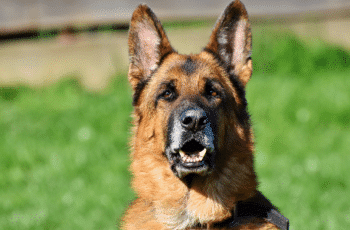All dogs have rod-dominated retinas that allow them to see well in the dark. Also, with superior night vision, dogs have better motion visibility than humans have. However, because their retinas contain only about one-tenth of the concentration of cones (that humans have), dogs do not see colors as humans do.
So how does this affect our dogs?
20 Things You Should Know About Your Dog’s Vision
 1. Dogs cannot distinguish red from green as we can.
1. Dogs cannot distinguish red from green as we can.
According to a study by the University of Florida, dogs have two types of photoreceptors in their retinas: rods, which allow them to see well in low light conditions, and cones, which help provide color vision.
Dogs have only two types of cones – one is sensitive to yellow, green, and blue light; the other is sensitive to yellow, blue-ish, and deep red. This implies that dogs see two more colors than humans do.
2. Dogs cannot see infrared light but can see far-red light.
Infrared light is invisible to humans but visible to our canine friends. This wavelength of light has a longer wavelength than is visible to humans and can penetrate glass windows.
3. Dogs cannot see ultraviolet light but can see far-blue light.
The eyes of dogs and humans do not have the same wavelength sensitivity. Dogs also have a much higher concentration of rod-like cells than we do, allowing them to see in low-light conditions better than we can see with rods alone.
4. Dogs cannot detect polarized light.
While we humans see polarized light with sunglasses, dogs do not. However, if you’re willing to remove your sunglasses in the fall or winter, it’s possible to guide your dog through a maze with polarized glasses!
5. Dogs cannot detect infrared or ultraviolet light with their eyes but can detect them with “heat-sensing” noses and ears.
In other words, they are “heat-detecting” animals.
This ability to sense heat is a fundamental way for dogs to understand their environment and communicate with each other. This also affects their ability to detect the chemical stimuli of a drug in the environment.
 6. Dogs are colorblind.
6. Dogs are colorblind.
Dogs can detect the color red but cannot see the difference between long-wavelength red and short-wavelength green. Because dogs are red-green colorblind, they may have difficulty interpreting signals from a traffic light or making choices that involve discriminating among varying shades of green.
7. Dogs have a different visual field than humans do.
Dogs’ eyes are placed on the sides of their heads, giving them a wider visual field than people. Because of this, dogs can see things we cannot and are better equipped to detect movement.
8. Dogs have poor depth perception.
Dogs have a lot more trouble judging the distance between themselves and the objects they’re trying to locate in their environment. This is because humans see an angled line on our retina called the “optic chiasm” while dogs do not. This is why it is difficult for dogs to be distracted by a flashlight.
9. Dogs have better motion perception than humans do.
This has to do with the fact that dogs can only see through one eye instead of two as we can. Dogs, therefore, have a much larger field of vision than humans and more acutely notice movement in their surroundings.
10. Dogs can see things further than humans can.
According to the University of Florida, dogs have a visual range of approximately 320-400 feet. Surprisingly, though we would think dogs would be handicapped in terms of natural vision without color vision, they can distinguish between shades better than humans do. Dogs can detect a greater variety of colors than humans, and their ability to see movement is much better.
 11. Dogs can see more colors than we can. Dogs can see colors but not recognize them as colors.
11. Dogs can see more colors than we can. Dogs can see colors but not recognize them as colors.
Humans have three types of cones, which are sensitive to red, green, and blue-ish light. Dogs have only two types of cones – one is sensitive to yellow, green, and blue light; the other is sensitive to yellow, blue-ish, and deep red. This implies that dogs see two more colors than humans do.
According to a study by the University of Florida, dogs have two types of photoreceptors in their retinas: rods, which allow them to see well in low light conditions, and cones, which help provide color vision. Humans have three types of cones, which are sensitive to red, green, and blue-ish light.
12. Dogs can see better in dim light than we can.
Dogs also have a larger cornea and pupils, which are responsible for their superior night vision. Their retinas’ rods are more sensitive to light than those in humans. They contain a higher concentration of rhodopsin (a photopigment found in the rods that helps detect motion), which allows them to have improved vision at night or in low light. Dogs do not see well at night. Dogs see better in dim light than humans, but they still can’t compete with cats.
Humans have three types of cones, which are sensitive to red, green, and blue-ish light. Dogs have only two types of cones – one is sensitive to yellow, green, and blue light; the other is sensitive to yellow, blue-ish, and deep red.
13. Dogs can see in “black and white.”
Dogs can see in “black and white,” just like we do! They have a particular type of visual sensory cells called rod cells (or rods for short) activated by dim light. Rods are responsible for our ability to see in “black and white” and are responsible for visual acuity under low light conditions. Here is an excerpt from the Dog Awareness Project’s website: “For dogs, color vision is less important than for humans. Dogs are not as discerning as humans when it comes to color, and they do not need to discern small changes in color. Generally, dogs see humans and other living things with a yellowish-green tinge. Colors that we perceive in the red part of the color spectrum (tint) appear dark brownish-black to dogs, so red lights at night are invisible to them. Red light does not provide any help with night vision.”
14. Dogs are not thought to be capable of seeing in shades of gray.
This is because we humans can see shades of gray (you probably know that a light cloud has different shades of gray from dark clouds). Dogs do not have the equivalent of retinal receptors that can detect color or shades of grey. This means that dogs see the world in shades of black and white, and they do not see shades of gray. As a result, dogs do not see the world as we humans do. We can see “black,” but a dog may only be able to see “black” if they are looking at a black object (such as a black car).
 15. Dogs do not have 3D vision.
15. Dogs do not have 3D vision.
Dogs do not see in 3-D – although they can distinguish depth, they interpret space and distance as flat. We, humans, perceive our environment with a two-dimensional (2-D) screen that we call the visual field. A dog’s world looks like a three-dimensional (3-D) world to them, and that’s why dogs appear to move and respond differently than we do to things in their environment.
16. Dogs see in front of them.
To a dog, what’s in front is more important than what’s behind. So a dog may not even notice someone standing behind them, but they will notice someone standing in front of them.
17. Dogs do not see as well at close range as we do.
Dogs have a wider field of vision than humans, but they can’t see objects that are in front of them very well, nor can they see far away things (like a human walking across the street).
18. Dogs’ vision deteriorates with age.
Their eyesight changes as they grow older. As dogs get older, their eyesight becomes worse because of the degeneration of cells in the retina.
19. Dogs do not need corrective lenses as we do.
Dogs do not have a prescription for glasses and do not require corrective lenses. They can see perfectly without them! However, dogs that are born with retinal defects or suffer from detached retinas may need special care and may require cataract surgery.
20. Dogs cannot see items that are too far away.
They cannot see an object 100 yards away or farther if it’s not in their field of vision. But dogs see movement better than we do.
They have a wider field of vision than humans, but they can’t see objects in front of them very well, nor can they see far away things (like a human walking across the street).
 In Summary
In Summary
Dogs have a range of vision that is similar to humans. However, they do not see color the same way we do! They only see color when it contrasts enough with the surrounding light. For example, red looks black or brown to a dog, and blue looks gray or black. Their view of the world is different than what we see and often don’t see. Their vision is not as good as humans, but they do have a different eye to see in the dark and have the ability to see in black and white. They can see better in low light conditions than humans, but they still cannot see our red lights at night. Also, their senses of vision are different from that of humans. Although they can see further than us, their sense of space is limited. So consider these things as you live and travel with your pet dog.


